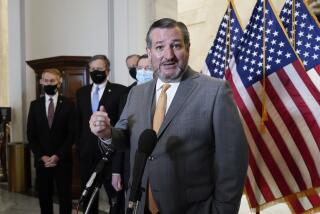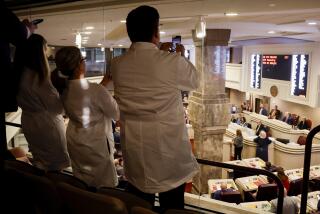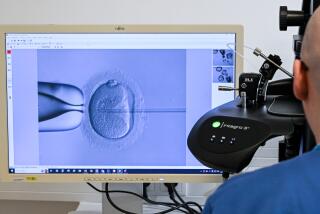Doctors Seek Means of Using Babiesâ Organs
LOMA LINDA, Calif â Physicians and ethicists at Loma Linda University Medical Center are drafting procedures to allow more brain-dead anencephalic babies to be used as organ donors, Dr. Leonard Bailey, the pioneering infant heart surgeon, said Wednesday.
At the same time, Bailey flatly ruled out âus or anyone else in the near futureâ utilizing anencephalic babies who are not brain dead as organ donors, a prospect that has triggered an emotional medical and ethical debate over the last several years.
Several thousand anencephalic babies are born in the United States each year missing the higher brain centers that control human thought and feelings but with an intact brain stem that sustains such basic functions as heartbeat and respiration. They usually die within hours or days of birth.
âI Am Part of Humanityâ
âI am not wacko; I am part of humanity. . . . I would not take the heart out of anybody who is still breathing and moving and kicking around,â Bailey said in an interview after a symposium on anencephalic organ donors that was attended by more than 200 physicians, medical students and journalists.
Under the proposed policy, apparently the first of its kind, Loma Linda physicians would have the option, with the permission of the babyâs parents, to place an anencephalic baby on a respirator at the time of birth and thereby try to prevent the deterioration of their organs that might make them useless for transplants.
According to Bailey, an anencephalic baby could then be maintained on a respirator for a specified period of time while it was tested to see if breathing and other reflexes had ceased and it had become brain dead. The period of time has not been determined, but it might be between three and five days. The baby also would not be given any medications that might interfere with breathing and hasten the diagnosis of death, he said.
If the baby became brain dead within the specified time, its organs could be used for transplant surgery, according to Bailey. But if it remained alive beyond the specified time, it would be disconnected from the respirator and allowed to die a natural death.
Not Yet Completed
Bailey and David R. Larsen, an associate professor of Christian ethics at Loma Linda, emphasized that the proposed procedures had yet to be completed and submitted to medical center officials for approval.
But the proposal may prove controversial. Some ethicists have contended that placing an anencephalic newborn on life support crosses into uncharted territory by prolonging life not for the benefit of the patient but for the sole purpose of harvesting organs. Moreover, the maintenance of such babies on respirators may make it more difficult to diagnose when they actually die.
âWhen we play with the legal notions of who is dead and who isnât in order to save the life of somebody else, it makes everybody just a tad uncomfortable,â said Leslie Rothenberg, a UCLA faculty member who specializes in medical ethics and a participant in the symposium.
Last month, Bailey made medical history in North America when he used a heart for transplantation from a Canadian-born anencephalic girl named Gabrielle who had been maintained on a respirator until her entire brain, including the brain stem, died.
Body Flown to Loma Linda
The body of Gabrielle, still maintained on life support, was then flown from Childrenâs Hospital in London, Ontario, Canada, to Loma Linda, where Bailey implanted her heart into the chest of newborn Baby Paul Holc, who was born with a fatal heart defect.
Since that time, Bailey said, he had been notified of another potential brain-dead anencephalic heart donor at the same Canadian hospital, but the donor had to be rejected because it had the wrong blood type.
In addition, he said, Loma Linda has been contacted by physicians and parents about another 15 potential anencephalic donors, all of whom were âturned downâ because the babies were either yet to be born or were not brain dead.
âIf the situation ever arises again and a baby is brain dead and anencephalic, we will use that organ,â Bailey said. â(But) I donât think I could ever conceive of us or anyone else in the near future utilizing anencephalics who are not brain dead.â
The symposium featured a sharp exchange between Bailey and UCLAâs Rothenberg on the anencephalic donor issue.
Calls for Debate
Bailey maintained that anencephalic babies are not âpersons by anyoneâs stretch of anyoneâs imagination.â He called for a âpragmaticâ debate on âhow this very vital resource could be utilized without us sacrificing any of what we consider our humanity and our own personhood.â
But Rothenberg, a member of UCLAâs heart transplant team, strongly disagreed, stating his concern that the concept of ânon-personhoodâ would be subsequently applied to others, such as brain-damaged infants, adults in persistent comas and elderly patients with severe dementia.
âThere have been historical instances where the definition of non-personhood has cost people their lives,â Rothenberg said. He cited the term âuseless eaters,â which was applied in post-World War I Germany to the physically handicapped and mentally defective and later extended to Jews, Soviet prisoners of war and others considered valueless to Nazi Germanyâs economy.
âThe larger question boils down to this,â Rothenberg concluded. âIs the killing of a person justified if motivated by saving the life of another who is not threatened by the person killed? If the answer is âyesâ or âperhaps,â than we all have something to fear by these developments.â
More to Read
Sign up for Essential California
The most important California stories and recommendations in your inbox every morning.
You may occasionally receive promotional content from the Los Angeles Times.










